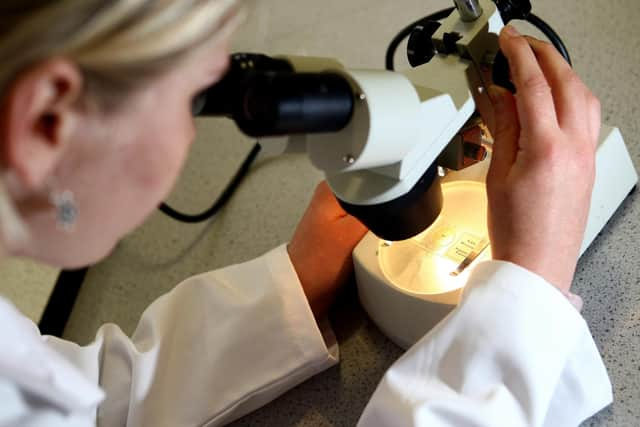Scottish scientists breakthrough could help regrow bones in injured patients
Scottish researchers say they have discovered a bioengineering breakthrough which would allow broken bones to heal quicker in seriously injured patients.
Scientists at the University of Glasgow have found a new way to harness the powerful healing effect of ‘growth factors’ – naturally-occurring molecules which help the body to regenerate.
Advertisement
Hide AdAdvertisement
Hide AdGrowth factors play an important role in developmental biology, helping to organise the development of bodies as they grow from infancy into adulthood.


They also help the body to heal after injuries, where they initiate a complex series of processes which knit tissues back together.
Growth factor therapies often have serious side-effects when used to heal bones - but the Glasgow research team believes an inexpensive polymer called poly(ethyl acrylate), or PEA, can be used with minimal negative effects.
Current growth factor therapies can cause unintended bone formation – a process known as ectopic bone formation, and can cause other side effects like postoperative inflammation.
Dr Udesh Dhawan, a research fellow at the University of Glasgow’s James Watt School of Engineering, said the biological processes that underpin the research have been understood for more than two decades, but “this is the first time that they’ve been harnessed to produce this regenerative effect”.
“Being able to deliver immobilised proteins directly to the treatment site in this way provides much more control over how growth factors become active and start the healing process,” said Dr Dhawan.
“It also works at much lower concentrations than previous treatments, helping further minimise the chances of unwanted bone growth beyond the site in need of healing.”
The team’s findings build on years of advanced bone regeneration research led by the University of Glasgow’s Professor Manuel-Salmeron-Sanchez and Professor Matthew Dalby.
Advertisement
Hide AdAdvertisement
Hide AdTheir work includes a landmark treatment which saved a badly injured dog’s leg from amputation in 2017.
In that treatment, the team harnessed the growth factor potential of a protein called BMP-2 bonded to a PEA surface to regrow bone in the dog’s leg.
Professor Salmeron-Sanchez, co-director of the University of Glasgow’s Centre for the Cellular Microenvironment, said growth factors are “very powerful tools” for helping the body heal, but “currently they need to be very carefully applied to prevent negative side effects cancelling out any positive therapeutic benefits”.
“Our approach to controlling the activation of growth factors could create new opportunities for patients in the future.
“It could help regrow bone for patients who have lost large sections to diseases like cancer or through serious accidents, providing a much higher quality of life for them.”
Dr Dhawan added: “This is a new step in the right direction, but physiological systems are more interconnected than we can imagine and how this new strategy affects other crucial components of the body such as immune cells still needs to be evaluated.
“Nevertheless, these are very encouraging results, which suggest that this new treatment could have real benefits in clinical settings to encourage bone regeneration.”
Comments
Want to join the conversation? Please or to comment on this article.